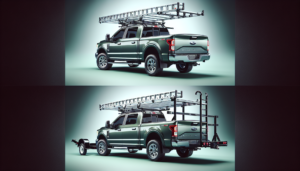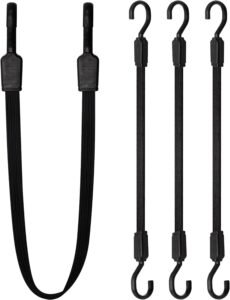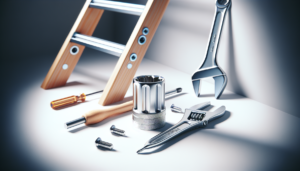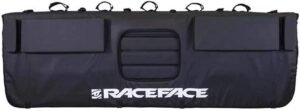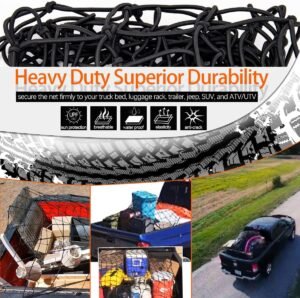If you find yourself changing vehicles as your needs or circumstances evolve, you may be wondering if it’s possible to transfer your trusty ladder rack from one truck to another. Well, the good news is that with the right planning and equipment, it is indeed possible to make the move. In this article, we’ll explore the factors to consider and the steps to take when transferring your ladder rack, ensuring a smooth transition between your trucks and keeping your equipment secure along the way. So, whether you’re a seasoned tradesperson or a weekend warrior, let’s dive into the world of ladder rack transferability and discover how to make the switch with ease.
Can I Transfer My Ladder Rack?
If you’re contemplating changing vehicles and wondering whether you can transfer your ladder rack, you’re not alone. Many people are unsure about whether it’s possible or practical to move their ladder rack from one truck to another. Luckily, the answer is yes, it is often possible to transfer your ladder rack as long as you carefully consider a few important factors. In this article, we’ll discuss the key considerations when it comes to transferring a ladder rack, including compatibility with different truck models, installation requirements, understanding weight limits, and the step-by-step transfer process.
Factors to Consider
Before you start planning the transfer of your ladder rack, there are a few important factors that you should take into consideration. These factors will play a crucial role in determining whether your ladder rack can be successfully transferred and effectively utilized on your new truck. Let’s explore these factors in more detail.
Design and Mounting System
The first factor to consider is the design and mounting system of your ladder rack. Different ladder racks have varying designs, some which may be compatible with a wide range of truck models, while others may be specifically designed for certain trucks. You need to ensure that the design of your ladder rack is suitable for the new truck you plan to transfer it to.
Condition and Age of the Ladder Rack
Another essential factor to assess is the condition and age of your ladder rack. Take a close look at your ladder rack to check for any signs of wear and tear, rust, or corrosion. If your ladder rack is in poor condition, it may not be wise to transfer it to your new truck. A ladder rack that is old or damaged may not provide the necessary stability and safety required for carrying your equipment securely.
Type of Truck Bed
The type of truck bed on your new vehicle is another crucial consideration. Truck beds come in various sizes and dimensions, such as standard, short, and extended beds. It’s important to verify that your ladder rack is compatible with the dimensions and specifications of the new truck bed. Otherwise, it may not fit properly or securely, leading to potential safety hazards.
Potential Modifications
In some cases, you may need to make modifications to your ladder rack to ensure a proper fit on your new truck. This could involve adapting the mounting system, adjusting the rack’s dimensions, or seeking professional assistance for customization. It’s crucial to assess whether modification is necessary and whether you have the ability to make these adjustments or require professional help.
Now that we’ve covered the essential factors to consider let’s delve into more specific details regarding compatibility with different truck models.
Compatibility with Different Truck Models
When it comes to compatibility, there are two main types of ladder racks to consider: generic and vehicle-specific. Understanding the differences between these two options will help you determine whether your ladder rack can be successfully transferred to your new truck.
Generic vs. Vehicle-Specific Ladder Racks
Generic ladder racks are designed to fit a wide range of trucks, regardless of the make and model. These racks typically offer adjustability and customization options, making them more versatile. However, they may not provide as secure and stable a fit as a vehicle-specific ladder rack that is specially designed to fit a particular truck model.
Vehicle-specific ladder racks are precisely tailored for a specific truck make and model, ensuring a perfect fit and maximum stability. If your ladder rack is designed specifically for your old truck, it may not be compatible with your new one. However, if you have a generic ladder rack, there is a higher likelihood of successful transfer if the dimensions of your new truck bed match.
Adjustability and Customization Options
Some ladder racks offer adjustability and customization options, allowing them to be adapted to fit different truck beds. These racks often have adjustable mounting systems or modular components that can be reconfigured to accommodate various truck models. If your ladder rack has these features, it increases the likelihood that it can be successfully transferred to your new truck.
Measuring Your New Truck Bed
Before attempting to transfer your ladder rack, it’s crucial to measure the dimensions of your new truck bed. Measure the length, width, and height of the bed to ensure compatibility with your ladder rack. It’s also important to consider any unique features or variations in your truck bed design that could potentially affect the installation and stability of your ladder rack.
With compatibility covered, let’s move on to discussing the installation requirements for transferring a ladder rack.
Installation Requirements
The process of transferring a ladder rack from one truck to another involves several installation requirements. It’s important to follow these requirements to ensure a secure and stable mounting of your ladder rack on the new truck.
Removing the Ladder Rack from the Old Truck
Before you can install your ladder rack on the new truck, you need to remove it from the old truck. This process may vary depending on the specific design and mounting system of your ladder rack. Follow the manufacturer’s instructions or seek professional guidance if you’re unsure about how to safely remove the ladder rack from your old truck.
Preparing the New Truck Bed
Once the ladder rack is removed from the old truck, you need to prepare the new truck bed for installation. This may involve cleaning the bed to remove any debris or dirt that could interfere with the installation process. It’s also essential to verify that the truck bed is in good condition and free from any obstructions or damage that could affect the installation or stability of the ladder rack.
Securing the Ladder Rack on the New Truck
Next, you need to secure the ladder rack on the new truck. This process will depend on the specific mounting system of your ladder rack. Some racks may require drilling into the truck bed for a secure fit, while others may offer a no-drill installation option. Follow the manufacturer’s instructions carefully to ensure the ladder rack is securely attached and properly aligned.
Now that we’ve covered the installation requirements, let’s shift our focus to understanding weight limits and the importance of proper weight distribution.
Understanding Weight Limits
Transferring a ladder rack to your new truck involves considering weight limits and ensuring that your equipment and the rack itself fall within the manufacturer’s specifications. Failing to comply with weight limits and distribution guidelines can lead to safety hazards and potential damage to your truck.
Manufacturer’s Weight Limit Specifications
Every ladder rack has weight limit specifications set by the manufacturer. These limits indicate the maximum weight the rack can safely support without compromising its structural integrity or the stability of your truck. It’s essential to consult the specifications provided by the manufacturer to ensure your load does not exceed the weight limits.
Considering the Weight of Your Ladder and Equipment
When transferring your ladder rack, you should take into account the weight of your ladder and any other equipment you plan to carry on the rack. Add up the weights of all your items to ensure they are within the weight limits specified by the manufacturer. Exceeding these limits can lead to instability, increased wear and tear on your truck, and potentially dangerous situations.
Ensuring Proper Weight Distribution
In addition to staying within the weight limits, it’s crucial to distribute the weight evenly across the ladder rack and the truck bed. Improper weight distribution can affect the stability and handling of your truck, particularly when driving on highways or uneven terrain. Make sure to distribute the weight evenly and secure all items properly to maintain optimal balance and safety.
Now that we have a good understanding of weight limits, let’s dive into the step-by-step process of transferring your ladder rack to your new truck.
Transfer Process Steps
Transferring a ladder rack from one truck to another requires following a specific set of steps to ensure a smooth and successful transfer. Let’s outline these steps:
Inspecting and Cleaning the Ladder Rack
Start by inspecting your ladder rack for any signs of damage or wear. Check the rack’s components, bolts, and fasteners to ensure everything is in good working condition. Give the rack a thorough cleaning to remove any dirt, dust, or debris that may have accumulated over time.
Gathering the Necessary Tools
Before you begin the transfer process, gather all the necessary tools that you’ll need to remove the ladder rack from the old truck and install it on the new one. This may include wrenches, a socket set, drill bits, and any other tools specified in the manufacturer’s instructions.
Removing the Ladder Rack from the Old Truck
Follow the manufacturer’s instructions or seek professional assistance to safely remove the ladder rack from the old truck. This may involve loosening bolts, disconnecting any electrical wiring, and carefully lifting the rack off the truck bed. Take your time and exercise caution to avoid any damage or injury during this step.
Preparing the New Truck Bed
Clean the new truck bed thoroughly and ensure it is free from any debris or obstructions that could interfere with the installation process. Take measurements of the truck bed to verify compatibility with your ladder rack, as discussed earlier. If any modifications or adjustments are necessary, such as drilling holes or adapting the mounting system, follow the manufacturer’s instructions carefully.
Securing the Ladder Rack on the New Truck
Once the new truck bed is prepared, it’s time to install and secure the ladder rack. Follow the manufacturer’s instructions for your specific ladder rack model to ensure proper alignment and secure attachment. Tighten all bolts and fasteners according to the recommended torque specifications.
Adjusting and Testing the Stability
After securing the ladder rack on the new truck, make any necessary adjustments to ensure proper fit and stability. Double-check all connections and fasteners to ensure they are tight and secure. Perform a stability test by gently shaking the ladder rack to ensure it doesn’t wobble or shift. If any issues are detected, make the necessary adjustments or seek professional assistance before relying on the ladder rack for heavy loads.
With the transfer process steps covered, let’s briefly discuss design and mounting systems to provide further insight.
Design and Mounting System
When considering the transfer of your ladder rack, it’s important to understand the different design and mounting systems available. Various options exist, each with its own advantages and considerations.
Universal Mounting Systems
Some ladder racks feature universal mounting systems that allow them to be installed on a wide range of truck models. These systems often use adjustable brackets or clamps to accommodate different bed widths and heights. Universal mounting systems provide versatility and ease of installation, making them a popular choice for those seeking compatibility across multiple trucks.
Drilling Required vs. No-Drill Installation
Ladder racks may require drilling into the truck bed for a secure fit, while others offer a no-drill installation option. Determine your preference and consider any potential implications of drilling into your truck bed, such as warranty concerns or long-term effects on the vehicle’s resale value. Additionally, check whether your new truck bed has pre-existing mounting holes that could be utilized for a no-drill installation.
Bolt-On vs. Clamp-On Designs
Ladder racks come in both bolt-on and clamp-on designs, each having its own advantages. Bolt-on designs tend to offer a more secure and permanent attachment, while clamp-on designs provide easier installation and the flexibility to remove or transfer the rack more easily. Consider your specific needs and preferences when deciding between the two.
Now that we’ve covered the design and mounting systems, it’s important to assess the condition and age of your ladder rack before transferring it to a new truck.
Condition and Age of the Ladder Rack
The condition and age of your ladder rack are vital considerations when contemplating a transfer to a new truck. Here are some key aspects to keep in mind when assessing your ladder rack’s condition:
Visual Inspection
Perform a visual inspection of your ladder rack, meticulously checking for any signs of damage, rust, or corrosion. Look for any bent or cracked components that could compromise the structural integrity and stability of the rack. If you notice any issues that are beyond minor cosmetic imperfections, it may be best to consider purchasing a new ladder rack for your new truck.
Structural Integrity
Ensure that all components of the ladder rack are structurally sound. Give the rack a firm shake to test for any excessive movement or weak points. The structural integrity of the ladder rack is crucial for its safe and reliable function, so any compromises in this area should be carefully evaluated before attempting to transfer the rack.
Rust and Corrosion
Ladder racks are exposed to various environmental conditions that can lead to rust and corrosion over time. Inspect your ladder rack for any signs of rust, paying particular attention to the joints and areas where the paint may have chipped or worn off. Minor surface rust can usually be remedied with proper cleaning and treatment, but extensive rust and corrosion may compromise the rack’s strength and durability.
Compatibility with New Truck
Consider whether your ladder rack is compatible with the new truck’s design. The dimensions and features of your new truck bed, such as bed rails or utility track systems, should be compatible with the mounting system of your ladder rack. Evaluate whether any modifications are necessary to ensure a safe and secure fit.
Lastly, let’s discuss some considerations related to the type of truck bed, as this can greatly impact the compatibility and transferability of your ladder rack.
Type of Truck Bed
The type of truck bed plays a significant role in determining whether your ladder rack can be successfully transferred to a new vehicle. Consider the following aspects when assessing compatibility:
Standard vs. Short vs. Extended Beds
Truck beds can vary in length, with standard, short, and extended bed options available. These bed lengths directly impact the dimensions and suitability of your ladder rack. Ensure that your ladder rack is designed to fit the specific bed length of your new truck to avoid any compatibility issues.
Bed Dimensions
Take precise measurements of your new truck bed to ensure it matches the required dimensions for your ladder rack. This includes considering the width, height, and length of the bed. Having accurate measurements is crucial to determining whether your ladder rack can be effectively transferred and securely installed on the new truck.
Specific Requirements for Compatibility
Certain truck models may have specific requirements or features that affect compatibility with ladder racks. For example, trucks with bed rail systems or utility track systems may necessitate specific ladder rack designs or additional accessories for proper installation. Verify that your ladder rack can accommodate any special features or requirements of your new truck bed.
In some instances, modifications may be necessary to ensure compatibility and a proper fit. Let’s briefly touch upon potential modifications that may be needed.
Potential Modifications
When transferring a ladder rack to a new truck, there might be situations where modifications are required for a proper fit. Here are some potential modification scenarios to consider:
Adapting the Mounting System
If your ladder rack’s mounting system doesn’t align with the new truck bed, you might need to adapt the mounting system. This can involve adjusting the brackets or adding additional components to achieve a secure and stable fit. Consult the manufacturer’s instructions or seek professional assistance when making modifications to ensure they are done correctly.
Making Adjustments for a Proper Fit
To ensure a proper fit on your new truck, you may need to make adjustments to the ladder rack itself. This could involve modifying the dimensions or configuration of the rack to match the truck bed’s specifications. Carefully assess your ladder rack’s design and consult with the manufacturer or a professional if you’re unsure about making the necessary adjustments.
Seeking Professional Assistance
If you’re unsure about transferring your ladder rack or uncomfortable with making modifications yourself, it’s always best to seek professional assistance. An experienced technician or installer can evaluate your situation, advise on the safest and most effective options, and perform any necessary modifications or installations on your behalf.
In summary, transferring a ladder rack from one truck to another is often possible, provided you carefully consider the key factors mentioned in this article. Assess the compatibility with different truck models, understand the installation requirements, determine weight limits, and follow the step-by-step transfer process. By taking a systematic approach and paying attention to detail, you can successfully transfer your ladder rack to your new truck, ensuring stability, safety, and functionality for the long haul.
